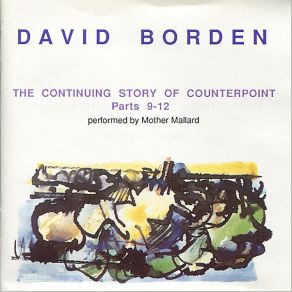The Continuing Story of Counterpoint Parts 9-12
Download links and information about The Continuing Story of Counterpoint Parts 9-12 by David Borden, Mother Mallard. This album was released in 1990 and it belongs to Electronica, Rock genres. It contains 6 tracks with total duration of 01:09:14 minutes.

|
|
|---|---|
| Artist: | David Borden, Mother Mallard |
| Release date: | 1990 |
| Genre: | Electronica, Rock |
| Tracks: | 6 |
| Duration: | 01:09:14 |
| Buy it NOW at: | |
| Buy on iTunes $9.99 | |
Tracks
[Edit]| No. | Title | Length |
|---|---|---|
| 1. | Part Nine (1980) | 15:48 |
| 2. | Part Ten (1987) | 19:15 |
| 3. | Part Eleven (1986) | 13:30 |
| 4. | Part Twelve A (1987) | 7:16 |
| 5. | Part Twelve B (1987) | 7:25 |
| 6. | Part Twelve C (1987) | 6:00 |
Details
[Edit]Borden composed Parts 9-12 of his Counterpoint series mainly between 1986 and 1987, about a decade after the series' earliest pieces. At this point, he seems somewhat more adventurous, pushing against the boundaries of his own rules. Consequently, there is a noticeable development in the contrapuntal language, with somewhat softer timbres and perhaps a bit more melodic invention. "Part 11" features a continually shifting tonal center and many related (but varying) melodic themes. Compared to the tightly controlled structures of the earlier Counterpoint recordings, this is extravagant and occasionally almost giddy, and almost certainly the most colorful part in the entire series. "Part 9" and "Part 10" feature the wordless soprano of Mother Mallard regular Ellen Hargis and sometimes sound like Brian Eno's prototypical Music for Airports ambience combined with the rhythmic pulse of early Steve Reich. According to Borden, "Part 10" is further distinguished as the only part in the series that includes improvisation, supposedly on alto flute, although solos by tenor and soprano saxes are written in a loose, improvisational style. (Many listeners will probably find the alto solos sounding the most improvised.) "Part 12A" starts with a lovely interlocking mallet pattern, very reminiscent of Reich, from which Borden builds a musical structure, with some vocalese from Hargis and two related patterns of long notes contrasting with the busy mallet progression. In "Part 12B," tuned electronic percussion is prominent for the first time in the series, and the relentless repetition and shrill timbres acquire an urgency that begins to suggest a touch of Gothic prog rock in the manner of Univers Zero. Borden's monumental Counterpoint series is brought to a close with "12C," a limpid, strangely muted piece that Borden indicates is meant to sound "dreamlike" and "inconclusive."